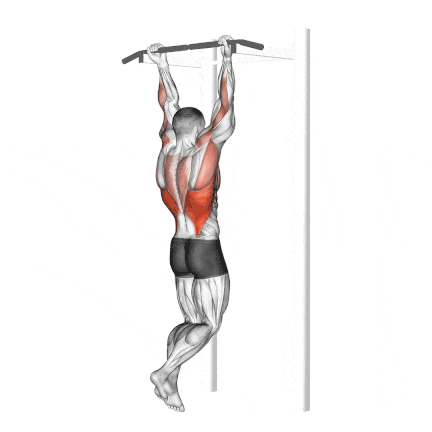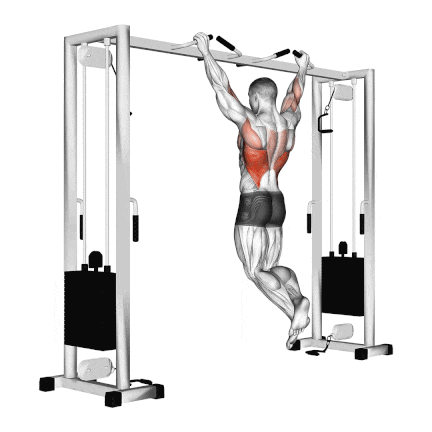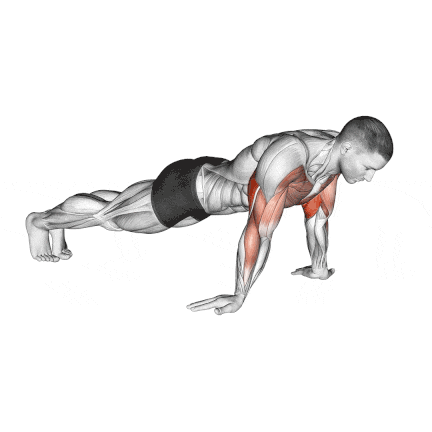Traditional weight training is excellent, but it’s not the only way to get bigger biceps. The right bodyweight movements can create enough tension to trigger muscle growth.
After 10+ years as a fitness trainer, I’ve found something amazing: bodyweight exercises can build serious arm muscle. They are easy to do and can be done anywhere.
This guide gives you 10 proven bodyweight biceps exercises that work. I’ve personally tested each one.
Let’s get started!

- 10 Best Bodyweight Biceps Exercises At Home
- 1. Inverted Row
- 2. Chin Up
- 3. Pull Up
- 4. Bicep Leg Curl
- 5. Towel Bicep Curl
- 6. Archer Pull-Ups
- 7. Lateral Plank Walk
- 8. Reverse Grip Push-Ups
- 9. Chaturanga
- 10. Towel Hammer Curl
- Bodyweight Bicep Workout Routine
- Beginner Bodyweight Bicep Workout Plan
- Intermediate Workout Routine
- FAQ’s
- How to combine bicep exercises into a home workout
- Can you train your biceps with bodyweight?
- Can you get big arms with bodyweight exercises?
- Other Bodyweight Exercises
10 Best Bodyweight Biceps Exercises At Home
Here are 10 exercises to build strong and lean biceps from the comfort of your home.
You can use these as part of a regular workout or as a standalone circuit.
1. Inverted Row
Inverted rows, also known as bodyweight rows, are a great exercise for targeting your bicep muscles and building strength in other areas, such as your middle back and core.
Think of it as the bodyweight equivalent of a seated cable row or a bent-over barbell row. The Inverted Row is a horizontal pull that works your back muscles and biceps as a powerful secondary mover.
Most people do this exercise on the Smith machine in the gym. But at home, you can also perform the inverted row by lying under a chair, holding the chair’s sides, and pulling yourself up.

How To Do
- Adjust the height of the chair and bar so that it’s a little higher than arm’s length from the floor.
- Lie under the bar with your legs and body straight.
- Grasp the bar with an overhand grip, a little wider than shoulder width.
- Walk your feet out until your body forms a straight line from your heels to your head. Your body should be suspended below the bar.
- The further your feet are placed from the bar (the more horizontal you are), the harder it will be. The closer your feet are (the more vertical you are), the easier it will be.
- Before pulling, brace your abs and glutes tightly. This keeps your body rigid like a plank and prevents your hips from sagging.
- Pull yourself up in a controlled manner. Bring your chest up and touch the bar or surface. Squeeze your biceps and back muscles at the top.
- Slowly and controllably lower yourself back to the starting position with straight arms. Repeat.
2. Chin Up
One of the best bodyweight exercises for your biceps is the chin-up. It induces serious muscle growth in the back and biceps.
When you can lift your entire bodyweight using an underhand grip, you are subjecting your biceps to a load that is incredibly difficult to replicate with improvised home equipment. This is where true, dense muscle growth happens.
Beginners can reduce body weight using a resistance band looped around the bar and under their feet or knees. I often start clients with a thick band and gradually reduce assistance.

How To Do
- Stand below the bar and grip it with an underhand grip (palms facing you). Your hands should be about shoulder-width apart, maybe slightly narrower.
- Hang from the bar with your arms fully extended. Your body should be relaxed but not completely limp. Engage your core slightly to prevent excessive swinging.
- Retract your shoulder blades and pull your body until your chin aligns with the bar. At the peak, squeeze your biceps and back muscles hard.
- Slowly lower yourself back down with control. Try to get a descent that takes at least 2 seconds.
- Once you’re back at the full hang, immediately transition into the next rep if possible, or pause briefly before starting the next pull.
3. Pull Up
Pull-ups are among the most effective bodyweight exercises for building a strong, defined upper body.
While it’s a close cousin to the chin-up, the pull-up’s overhand grip shifts focus to the back while still giving your biceps a solid workout
The pull-up is an upper-body strength movement that targets your back, chest, shoulders, and biceps.
Not everyone has a pull-up bar. I’ve taught clients how to use playground monkey bars, tree branches, or portable doorframe bars. Yoy can also try..

How To Do Pull Up
- Grasp the pull-up bar with an overhand grip (palms facing away from you).
- Your hands should typically be wider than shoulder width, often 1.5 to 2 times shoulder width.
- Hang from the bar with your arms fully extended.
- Tighten your abdominal muscles, ensure your body is hanging straight, and relax your shoulders but do not shrug them up.
- Use your back and biceps muscles to pull your body up towards the bar until your chin clears the bar.
- Slowly lower yourself back down to the starting position with straight arms. Control the movement throughout the entire range of motion. Repeat.
4. Bicep Leg Curl
Bicep leg curls, also known as bodyweight bicep curls, are an isolation exercise that targets the biceps brachii by using your leg as resistance.
I’ve found that the bicep leg curl is a great home workout for those who are intimidated by pull-ups or lack strength.
You sit on a chair or surface, place one hand under your thigh, and curl your arm to lift your leg, mimicking the motion of a dumbbell curl.
You can do a variation of the bicep leg curl while lying down.

How To Do
- Sit on a chair as close to the edge as possible.
- Then, place your right hand under your left thigh at the crease between your hamstrings and calves.
- Slowly curl your right up as high as possible—Exhale during this exercise portion.
- Hold for a couple of seconds. Then, slowly lower your leg back down, so your foot is just above the ground—Inhale during this exercise portion.
- Repeat for the desired number of reps.
- Repeat the exercise with your left arm.
5. Towel Bicep Curl
Towel bicep curls are an innovative, equipment-free exercise that targets the biceps using a towel and your body’s own resistance.
You can perform this exercise by standing with your back against the wall or lying or sitting on the floor, grabbing both ends of a towel, and putting one foot on a sling.
How To Do
- Use a long towel and fold or roll it lengthwise.
- Stand with your feet shoulder-width apart. Or sit comfortably on the floor. Extend your legs out in front of you. You can keep your knees straight or slightly bent.
- Find a position where your feet are stable and you can generate resistance comfortably.
- Step on one end of the towel with one foot to secure it to the floor.
- Grip the other end of the towel with the hand on the same side (e.g., right foot, right hand). Or from both hands.
- Keep your elbow close to your torso, and pull the towel upwards by bending your elbow, as you would in a regular bicep curl.
- Once your hand is close to shoulder level, hold the position momentarily.
- Slowly lower your hand back to the starting position.
Know More: 7 Best Resistance Band Bicep Exercises For Bigger Arm
6. Archer Pull-Ups
Archer pull-ups are a challenging variation of the traditional pull-up that primarily targets the upper body muscles, including the back, biceps, and shoulders.
This exercise involves pulling yourself up to one side and extending the opposite arm out to the side, mimicking the drawing of a bow, like an archer.

How To Do
- Grip the pull-up bar with a wide grip, wider than shoulder-width.
- As you pull yourself up, shift your weight to one side, extending the opposite arm straight out to the side.
- Your chin should reach or go slightly above the bar on the side you’re pulling towards.
- In the top position, one arm should be bent, doing most of the pulling, while the other arm is straight and extended.
- Lower yourself back to the starting position in a controlled manner.
- Repeat the movement, alternating the side you pull toward with each rep.
7. Lateral Plank Walk
The Lateral Plank Walk is a full-body exercise mainly targeting your core, shoulder, and biceps. Take a walk on the wild side as well, as wild as a plank can get.
This move intensely engages your core like a classic plank, but the side-to-side motion also works your arms and delts. Plus, it’ll challenge your balance and stability.
Taking huge steps makes it harder to control the movement and maintain core stability. Start with small, controlled steps.
How To Do
- Get into a high plank position. Your hands should be directly under your shoulders, fingers pointing forward.
- Your body should form a straight line from your head to your heels.
- Your body should form a straight line from your shoulders to your ankles.
- Take a step to the right, starting with your right hand and right foot and following with your left hand and foot, maintaining a plank position as you move.
- Do a set number of reps in one direction, and then repeat the same number of reps moving in the opposite direction.
8. Reverse Grip Push-Ups
The reverse grip push-up is a fun and great variation of the standard push-up. You do it with your fingers facing your feet (your palms outward).
Many consider it the “bicep push-up” because of the hand position; it emphasises your biceps more than the standard push-up.
You can do it on your knee or an inclined surface to make it easier.

How To Do
- Start in a standard push-up position and place your hands slightly wider than your shoulders.
- Your palms are flat on the floor, and your fingers point toward your feet.
- Inhale and slowly start to bend your elbows. Do not let your elbows move outwards (away from your body).
- Lower yourself until you are about an inch from the floor. When you are at the bottom, pause the movement for a second.
- Exhale and start pushing your body back up. Push through your palms like you would try to push the floor away from yourself.
- Finish the exercise by extending your arms completely out. Repeat this for however many repetitions you wish to perform.
9. Chaturanga
Chaturanga, also called Chaturanga Dandasana, is a yoga pose that resembles a low plank or a push-up in its halfway down position.
The term “Chaturanga” comes from Sanskrit, where “Chatur” means four and “Anga” means limb, referring to the four limbs that support the body in this position.
This workout tests how strong your grip is and how long you can hold it for. It helps you tone your arms and strengthens them.
How To Do
- Begin in a standard plank position with your shoulders over your wrists.
- Tighten your abdominal muscles to stabilise your body.
- Keep your elbows close to your body and ensure they don’t flare out to the sides.
- On an exhale, bend your elbows and keep them close to your body.
- Lower yourself until your elbows are at a 90-degree angle and your upper arms are parallel to the floor.
- Your body should be straight from your head to your heels.
- Either press back up to plank or transition through to an upward-facing dog or cobra pose in a yoga sequence.
10. Towel Hammer Curl
Simply changing your hand position to a neutral grip (palms facing each other), you shift the emphasis.
While your biceps are still working, this grip strongly engages the brachialis (the muscle underneath your biceps) and the brachioradialis (outer forearm muscle), while also challenging your grip strength.
How To Do
- Lie down or sit on the floor with your legs extended or slightly bent out in front of you.
- Hold the ends of the towel/band with a neutral grip (palms facing each other). Adjust your grip on the towel/band to create initial tension when your arms are mostly extended (but not locked out).
- Keep your elbows close to your torso, pull upwards on the towel by bending your elbows, like performing a dumbbell hammer curl.
- Once your hands are at about shoulder level, hold the position briefly.
- Slowly lower your hands back to the starting position.
Bodyweight Bicep Workout Routine
The bicep exercises listed will be performed with moderate loads and repetitions to emphasise muscular hypertrophy (muscle growth) and endurance.
Here are the best rep ranges and weekly bicep workout volume:
- For muscle hypertrophy (muscle growth): Aim for a rep range of 8–12 reps per set
- For strength and power: Lower the rep range to around 4–6 reps per set.
- For Endurance: Do 15–20 reps per set.
| Level | Repetitions | Sets | Total Sets Per Week | Frequency |
|---|---|---|---|---|
| Beginners | 8–10 reps | 2-3 | ~10 sets | 1–2 times per week |
| Intermediate | 10–12 reps | 3-4 | ~15 sets | 2–3 times per week |
| Advanced | 8–12 reps | 4-5 | ~20 sets | 2–3 times per week |
Beginner Bodyweight Bicep Workout Plan
| Exercise | Sets | Reps | Rest between Sets |
|---|---|---|---|
| Chin Up | 3-4 | 8-10 | 60-90 sec |
| Bicep Leg Curl | 3 | 10-12 | 60-90 sec |
| Lateral Plank Walk | 3 | 8-10 | 60-90 sec |
Intermediate Workout Routine
| Exercise | Sets | Reps | Rest between Sets |
|---|---|---|---|
| Reverse Grip Push-Ups | 4 | 8-10 | 60 sec |
| Chaturanga | 4 | 8-10 | 60-90 sec |
| Chin Up | 3-4 | 10-12 | 60 sec |
| Towel hammer curl | 3-4 | 8-12 | 60 sec |
FAQ’s
How to combine bicep exercises into a home workout
- Choose three of the exercises and do 8–12 repetitions.
- Do three sets of each exercise, with 90–120 seconds of rest between sets.
- During isometric exercises, try to hold the position as long as possible. Repeat this three times with 90–120 seconds of rest between sets.
Can you train your biceps with bodyweight?
You can build your biceps with bodyweight exercises. There are many ways to work out your biceps at home without weight:
- Inverted Row
- Chin Up
- Bicep Leg Curl
- Towel Bicep Curls
- Archer Pull Ups
- Reverse Grip Push-Ups
- Chaturanga
- Dive-Bomber Push-Up
- Towel Hammer Curl
- Pull Ups
Can you get big arms with bodyweight exercises?
Two things you need to build muscle are resistance and time under tension. Both of these can be achieved with bodyweight.
All of this can be done without any equipment in the comfort of your own home.
Other Bodyweight Exercises
- Bodyweight Chest Exercises
- Bodyweight Shoulder Exercises
- Best Bodyweight Back Workout
- Bodyweight Triceps Exercises
- Best Bodyweight Leg Exercises

Manish is a NASM-certified fitness and nutrition coach with over 10 years of experience in weight lifting and fat loss fitness coaching. He specializes in gym-based training and has a lot of knowledge about exercise, lifting technique, biomechanics, and more.
Through “Fit Life Regime,” he generously shares the insights he’s gained over a decade in the field. His goal is to equip others with the knowledge to start their own fitness journey.
